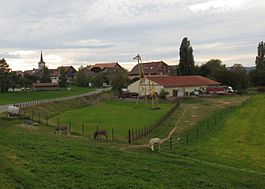Chesalles-sur-Moudon
| Chesalles-sur-Moudon | ||
|---|---|---|
| Former municipality of Switzerland | ||
 |
||
|
||
| Coordinates: 46°41′N 6°50′E / 46.683°N 6.833°ECoordinates: 46°41′N 6°50′E / 46.683°N 6.833°E | ||
| Country | Switzerland | |
| Canton | Vaud | |
| District | Broye-Vully | |
| Government | ||
| • Mayor | Syndic | |
| Area | ||
| • Total | 1.67 km2 (0.64 sq mi) | |
| Elevation | 702 m (2,303 ft) | |
| Population (2003) | ||
| • Total | 161 | |
| • Density | 96/km2 (250/sq mi) | |
| Postal code | 1683 | |
| SFOS number | 5666 | |
| Surrounded by | Brenles, Chavannes-sur-Moudon, Curtilles, Moudon, Sarzens | |
| Website | Profile (French), SFSO statistics |
|
Chesalles-sur-Moudon is a former municipality in the district Broye-Vully in the canton of Vaud in Switzerland. In 2017 the former municipalities of Chesalles-sur-Moudon, Brenles, Cremin, Forel-sur-Lucens and Sarzens merged into the municipality of Lucens.
Chesalles-sur-Moudon is first mentioned in 1273 as Chesales.
Chesalles-sur-Moudon had an area, as of 2009[update], of 1.67 square kilometers (0.64 sq mi). Of this area, 1.3 km2 (0.50 sq mi) or 77.8% is used for agricultural purposes, while 0.19 km2 (0.073 sq mi) or 11.4% is forested. Of the rest of the land, 0.17 km2 (0.066 sq mi) or 10.2% is settled (buildings or roads).
Of the built up area, housing and buildings made up 6.0% and transportation infrastructure made up 3.6%. Out of the forested land, all of the forested land area is covered with heavy forests. Of the agricultural land, 58.1% is used for growing crops and 17.4% is pastures, while 2.4% is used for orchards or vine crops.
The former municipality was part of the Moudon District until it was dissolved on 31 August 2006, and Chesalles-sur-Moudon became part of the new district of Broye-Vully.
The blazon of the municipal coat of arms is Per bend Gules and Argent, overall behind a Lion passant guardant holding a Scimitar a rising Sun all of Or.
Corcelles-sur-Chavornay had a population (as of 2015[update]) of 353. As of 2008[update], 4.5% of the population are resident foreign nationals. Over the last 10 years (1999–2009 ) the population has changed at a rate of -7.2%. It has changed at a rate of -9% due to migration and at a rate of 1.2% due to births and deaths.
...
Wikipedia




